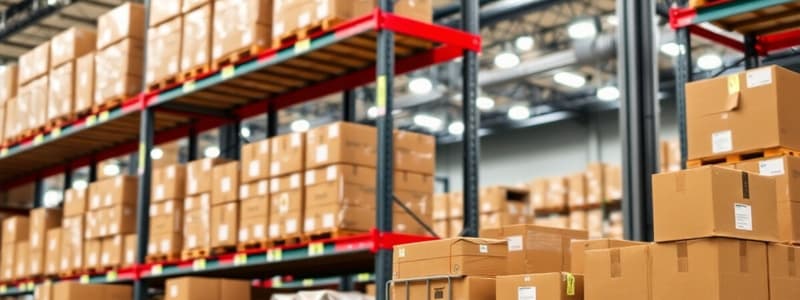Podcast
Questions and Answers
What is the primary goal of any distribution strategy?
What is the primary goal of any distribution strategy?
- To increase manufacturing efficiency
- To ensure consumers can find the product (correct)
- To minimize transport costs
- To enhance product design
Which channel of distribution allows a manufacturer to maintain a high level of control over how their product is marketed?
Which channel of distribution allows a manufacturer to maintain a high level of control over how their product is marketed?
- Intensive Distribution
- Selective Distribution (correct)
- Exclusive Distribution
- Integrated Distribution
What is a characteristic of Exclusive Distribution?
What is a characteristic of Exclusive Distribution?
- It allows retailers to negotiate pricing freely.
- It involves selling through as many outlets as possible.
- It limits product availability to one or two retailers. (correct)
- It is used for low-cost commodity items.
Which is NOT a component of distribution?
Which is NOT a component of distribution?
Which of the following is a potential advantage of intensive distribution?
Which of the following is a potential advantage of intensive distribution?
What is a primary concern addressed by logistics in distribution?
What is a primary concern addressed by logistics in distribution?
In which type of distribution might a company like IKEA fall?
In which type of distribution might a company like IKEA fall?
What is the primary function of channels of distribution?
What is the primary function of channels of distribution?
Which type of distribution channel involves intermediaries in the process of getting products to the consumer?
Which type of distribution channel involves intermediaries in the process of getting products to the consumer?
What is a key role of wholesalers in the distribution process?
What is a key role of wholesalers in the distribution process?
Which of the following is an example of a specialty channel of distribution?
Which of the following is an example of a specialty channel of distribution?
Which of the following is NOT a key function of wholesalers?
Which of the following is NOT a key function of wholesalers?
How do indirect channels like retailers differ from direct channels?
How do indirect channels like retailers differ from direct channels?
Which mode of transportation is ideal for small shipments needing fast delivery?
Which mode of transportation is ideal for small shipments needing fast delivery?
What is a characteristic of using trains for freight transportation?
What is a characteristic of using trains for freight transportation?
Which mode of transportation is most suitable for international shipments across water?
Which mode of transportation is most suitable for international shipments across water?
What is the primary use of pipelines in transportation?
What is the primary use of pipelines in transportation?
What is a key factor that affects the costs associated with trucking services?
What is a key factor that affects the costs associated with trucking services?
What does logistics primarily involve?
What does logistics primarily involve?
Which factor does NOT directly affect the cost of transportation?
Which factor does NOT directly affect the cost of transportation?
What does the term 'FOB Destination' mean?
What does the term 'FOB Destination' mean?
What is one disadvantage of using bulk transportation methods?
What is one disadvantage of using bulk transportation methods?
When does ownership of a product typically transfer under an FOB Source arrangement?
When does ownership of a product typically transfer under an FOB Source arrangement?
What does the weight of an item affect in transportation logistics?
What does the weight of an item affect in transportation logistics?
In the case of damaged goods transported FOB Source, who is held responsible?
In the case of damaged goods transported FOB Source, who is held responsible?
What role does the volume of goods play in transportation logistics?
What role does the volume of goods play in transportation logistics?
What is considered an important factor for a business when managing inventory levels?
What is considered an important factor for a business when managing inventory levels?
Which of the following best describes 'shrinkage' in inventory management?
Which of the following best describes 'shrinkage' in inventory management?
What does a high inventory turnover indicate?
What does a high inventory turnover indicate?
What is likely to happen if a business frequently runs out of stock?
What is likely to happen if a business frequently runs out of stock?
Which problem does effective inventory management help to prevent?
Which problem does effective inventory management help to prevent?
Flashcards are hidden until you start studying
Study Notes
Distribution
- All businesses must distribute their product to a consumer or a location where they can be found.
- Distribution is key to success because it ensures consumers eventually possess the product.
- Distribution is comprised of two components: channel selection & management and physically distributing goods through these channels.
- Distribution channels describe the path of ownership goods take from producer to consumer.
- Channel selection involves determining the best path for a product to reach its target consumer.
- Logistics are the processes involved in ensuring efficient, safe, affordable, and timely product movement.
Distribution Policies
- Intensive Distribution: Products are sold everywhere (e.g., Coca-Cola) and increase brand awareness, loyalty, and require large inventory.
- Selective Distribution: Manufacturers control product distribution and may avoid conflicts in positioning or brand image. Retailers cannot be refused product sales without a valid reason. It offers reduced cost and less exposure.
- Exclusive Distribution: Manufacturers partner with one or two retailers in an area to exclusively sell their products. This strategy promotes prestige and allows manufacturers to dictate retail strategies (e.g., high fashion clothing, luxury watches).
- Integrated Distribution: Manufacturers, distributors, or retailers own both distribution outlets and manufacturing facilities for a product (e.g., IKEA, Lee Valley tools).
Distribution Channels
- There are three types of distribution channels: Direct, Indirect, and Specialty.
- Direct channels involve the customer buying directly from the producer, with no intermediaries present.
- Indirect channels involve one or more intermediaries between the producer and the customer.
- Specialty channels are indirect channels that do not involve a physical retail store.
Direct Channels
- Direct channels require an integrated distribution policy.
- Examples include farmers' markets, bakeries, and restaurants.
Indirect Channels
- Importers are intermediaries who may or may not have exclusive rights to distribute a product in their country.
- Importers may seek out new products to import or be contacted by manufacturers looking to expand.
- Wholesalers purchase products from manufacturers and sell them to retail stores or other businesses.
- Wholesalers are necessary because manufacturers often have minimum order sizes that are too large for smaller retailers.
- Wholesalers perform key functions such as breaking bulk, transporting, risk bearing, managing, financing, promoting, buying, and providing market information.
- Retailers are the "front line," selling directly to consumers.
- Retailers must have the right merchandise, price, time, place, and quantity to be successful.
Specialty Channels
- Specialty channels utilize methods that do not involve a physical retail store.
- Examples of Specialty channels include vending machines, the internet, catalogues, telemarketing, and television sales.
Logistics
- Logistics involves purchasing, manufacturing, storage, and transportation of goods.
- Logistics managers consider factors like destination, weight, volume, and the type of goods when determining the best transportation method.
Transportation
- Transportation cost is affected by the distance goods need to travel.
- Heavier items typically cost more to transport.
- Bulkier items require more space and can potentially be containerized, which can also affect cost.
- Different goods may require special handling or specialized containers.
Free On Board (FOB)
- FOB determines the point at which responsibility for shipped goods transfers from the seller to the buyer.
- In "FOB destination", ownership transfers at the destination (where the goods are going).
- In "FOB source", ownership transfers at the origin (where the goods come from).
FOB Example
- If a good is damaged while being transported from the factory to the retail store, the buyer is responsible if the system is FOB source.
- If a good is damaged while being transported from the factory to the retail store, the producer is responsible if the system is FOB destination.
Common Types of Transportation
- Trucks: Offer door-to-door delivery and are crucial in logistics plans. Truck costs vary depending on the company. Goods are consolidated until enough for a full truckload (TL), which is more cost-effective.
- Trains: Efficient for large quantities of freight over long distances. Suitable for heavy, bulky, and hard-to-handle goods. They can transport across countries.
- Planes: Expensive but ideal for small shipments requiring quick delivery.
- Ships: Designed for large cargo and heavy weight but relatively slow. Ideal for international shipments across water, often less expensive than air transport.
- Pipelines: Used for transporting natural gas and crude oil.
Which Mode of Transportation?
- 10,000 flatscreen TVs from China to Future Shops across Canada: Likely a combination of ships (for the international portion) and trucks (for delivery within Canada).
- 20 tons of grain from Regina to the Weston Bakery in Toronto: Most likely a train due to the large quantity and long distance.
- 10 lbs of Otoro (tuna) from Tokyo to MHK Sushi in Ottawa: Air transport is ideal for this perishable item to ensure freshness and speed of delivery.
- 10 cases of maple syrup bottles from Gatineau to Montreal: Trucks would be a suitable choice for this relatively short distance and smaller quantity.
Inventory Management
- Integral part of the supply chain
- Determines how much of a product a business needs and when
- Controls overstocks, out-of-stocks, shrinkage and turnover
Overstock
- Having more stock than you can sell in a reasonable period of time
- Storing inventory costs money, uses space, ties up capital
- Old stock can depreciate quickly
Out-of-Stock
- Running out of inventory means you lose sales
- Can make customers angry, costing you future sales
Shrinkage
- Inventory that is lost due to breakage, damage and theft
- Effective inventory management prevents these things from happening
- Records when they do happen
Turnover
- The number of times a business sells its inventory in one year
- Shows how fast inventory is moving
- Different industries have standard turnover rates
- Formula: Cost of inventory Sold in 12 months / Average Inventory Investment for 12 months
- Low turnover = overstock
- High turnover = frequent out-of-stock
Studying That Suits You
Use AI to generate personalized quizzes and flashcards to suit your learning preferences.




